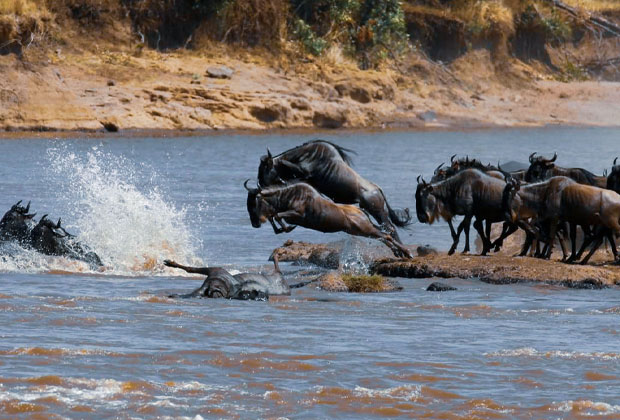Tanzania has a tropical climate that varies by region and altitude. The coast is generally hot and humid, while the low-lying parks are dryer and cooler. The best time to visit Tanzania is during the dry season from July to October, coinciding with the Great Wildebeest Migration.

The best season to visit Tanzania is during the long dry season, which falls from July to September. These are considered the best months for safaris, the Great Migration, trekking, and beach holidays in Zanzibar. Of course, these months are peak travel season. They will be busier, and some lodges, hotels, and parks will apply higher rates. If you prefer a more secluded experience, consider visiting during the short rainy season from the end of October to December. If possible, you'll want to avoid visiting during the long rainy season from March to May. The rains are often heavy and sudden, which can result in activities being cancelled last minut
January is fairly dry and hot, as the temperatures start rising after the short rains in November and December. There is a chance of some short showers, but they usually occur at night. It is the calving season on the Ndutu Plains, so visiting in January, especially towards the end of the month, is a great time to see wildebeest abound.
Temperatures continue rising, and the migration is still on the Ndutu Plains. February is one of the optimal months for trekking Kilimanjaro, for safaris in the northern and southern parks, and for visiting Zanzibar for a beach holiday. Like January, there is still a chance of short rains, but they also usually occur at night.
As the migration starts heading west towards the Grumeti River, the temperatures are still very hot. The beginning of the month is still great for trekking, safaris and beach trips. However, towards the end of the month, there is a higher chance of rain as Tanzania moves into the long rainy season.
In April, the long rainy season is in full swing. Travelling in this period is not advised, as torrential rains can affect planned excursions. Climbing Kilimanjaro is more dangerous during this season. Many lodges are also closed.
Just like April, May is a month of rain, so conditions are not ideal for travel. The lush vegetation, while beautiful, makes wildlife spotting more difficult.
Towards the beginning of June, the long rainy season ends, and Tanzania is blanketed by verdant vegetation and is a great time for bird-watching. By the end of the month, the savannah generally becomes drier and locating wildlife becomes easier. The migration begins heading north from Grumeti River in June.
July is the start of the peak season for travelling to Tanzania. The migration is heading towards Kenya, and elephants are gathering at Tarangire National Park. Visitors can avoid the crowds and high season prices by visiting the more remote parks on the southern safari circuit, like Ruaha and Selous. Visitors are advised to book early to have their preferred choice of lodge. July is also a good time to visit Zanzibar, as it is a bit cooler than the December to March period, but still dry. Nights, evenings, and mornings can also be cooler on the mainland, so some warmer clothes should be taken for early morning safari drives and sundowners in the bush.
Dry and cool, August is a great time to visit Tanzania. Wildlife starts searching for water sources, making their movements predictable for guides, and giving you a greater chance of seeing The Big Five. Flamingos also arrive in high numbers at Lake Natron, where they can find food and shelter at the otherwise eerie lake. Diving enthusiasts are happiest in August to September, when the water is especially clear. Turtles also hatch on the Indian Ocean islands.
The last month of the peak season, September can be quite busy, and prices are still high. The migratory herds of wildebeest and Zebra are spread out across the Serengeti. Gushing from the Northern Serengeti in Kenya, The Mara River is their biggest obstacle. Watching herds of wildebeest frantically swim across the crocodile-infested waters can be very exciting; there are often scenes of great fear and chaos, reminding travellers of the vicious circle of life on the African Plains. Water visibility in Zanzibar and on the coast is clear, and you may observe turtles hatching. .
Although it is not peak season any more, October is still quite dry and a good time for trekking, safari, or enjoying Tanzania's beaches. The migration is now in Kenya, but there are still plenty of animals to see. The short rainy season sometimes starts by the end of October, so the start of the month is better for travelling.
November is the start of the short rainy season. November and early December are both part of the low season, although most lodges remain open (unlike in the long rain season). Showers are mostly short and confined to the evening. As the plains and savannah become green again, birds - especially the migratory ones from the north - are easy to spot in the safari parks. The migration slowly travels back south from Kenya, so some isolated crossings may be spotted. Starting from November to March, whale sharks can also be seen on the shores of Zanzibar and Mafia.
Towards the middle of December, the short wet season is ending. There can still be some short rains throughout December to March, but these are usually overnight and only short. It’s a great month for visiting Zanzibar, as the temperatures are slowly rising. The days around Christmas can be quite busy again and prices can rise, so booking ahead is advised. .